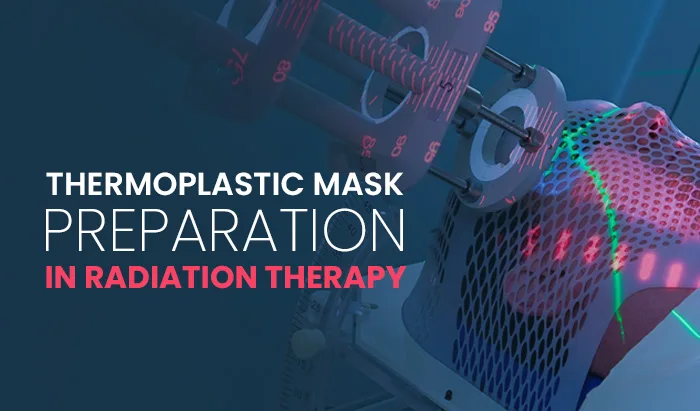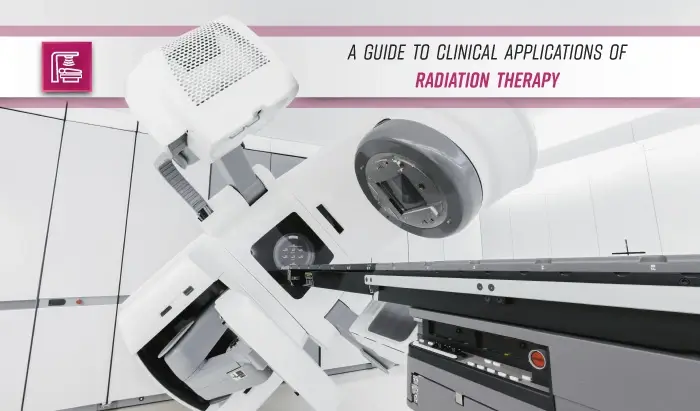How to Prepare a Thermoplastic mask for Radiation Therapy

How to Prepare a Thermoplastic mask for Radiation Therapy


Over half of cancer patients receive radiation therapy at some point during their treatment. It’s the most often used modality, it uses the linear particle accelerator (LINAC) for the locoregional treatment of cancer. LINAC utilizes ionizing radiation to locally destroy cancer cells and prevent them from multiplying while preserving the healthy tissue and surrounding organs. To achieve this, the patient should maintain a fixed and repeatable position for all radiation therapy sessions. Immobilization equipment meets this need. This article will focus on one of these fixation accessories: the thermoplastic mask for radiation therapy.
- When is a thermoplastic radiation mask used?
- What material are radiation masks made of?
- How to make a thermoplastic mask?
- Keep in mind
When is a thermoplastic radiation mask used?
For radiation therapy delivered to the head or neck area, it is mandatory to wear a radiation face mask during simulation and treatment sessions. Designed to be secured to a treatment table, this mask is used for head and neck tumors; brain, ENT (ear, nose, and throat) cancers, and metastasis. Click the link if you want to know more about the role of radiation therapists in CT simulation.
What material are radiation masks made of?
Thermoplastic masks are made of a plastic material and look like mesh. Patients wear the mask each day for treatment. In order to ensure the accurate delivery of the treatment, these masks are custom-made to precisely fit the patient’s face and hold their head and neck still in exactly the right position.
How to make a thermoplastic mask?
Equipment:
You will pick the type of radiation mask to be used during the simulation. Base your choice on the tumor’s location and the treatment protocol decided by the doctor. There are 3 types of masks:

Head mask used mostly for brain cancer

Head and Neck mask Used for ENT cancers

SRS mask used for Stereotactic radiosurgery
As we already mentioned, you must immobilize your patient with special devices in both the CT simulation and treatment room to have a reproducible position during treatment. Prepare the following equipment to make a radiation face mask:
- A water bath containing water heated to about 70 degrees Celsius (158 degrees Fahrenheit), where the thermoformed mask is soaked to become malleable.
- A personalized thermoformed mask that will adhere to the shape of the patient’s face.
- An adhesive tape which will be stuck on the made-up mask, on which the reference points and later on the isocenters will be marked.
- A flat or angled support, on which your patient will lie down, so as to horizontalize the spine and lower the shoulders as much as possible with the arm-rests.
- Headrests and foam cushions, to slide under your patient’s neck. They are available in several shapes and thicknesses, and must be chosen appropriately depending on the desired neck extension, your patient’s morphology, and their comfort.
- A mouthpiece to reproduce the opening of the mouth and push the tongue down and back to allow better protection.
- Markers for drawing the reference points.
- Lead balls to be fixed on the reference points.

Note that these accessories are imaging system compatible and do not produce artifacts.
Head and Neck mask preparation procedure:
- Preheat the water bath.
- Register your patient by entering identification details, such as their first and last name, their unique medical identification number, and the localization to be imaged on the CT simulator.
- Set up the appropriate immobilization devices on the scanner table: flat or angled support and headrest.
- Explain to your patient the procedure of the examination.
- Once your patient is ready, help them settle down on the table (taking into account their physical capacities) in a stable and comfortable position, as much as possible, while respecting the indications of the treatment plan.
- Align your patient in a supine position on the support with the appropriate head-rest and lower the shoulders as much as possible using the arm-rests.
- If using a mouthpiece, prepare it at this point. As your patient should put it inside their mouth and seal it.
- Acquire a scout view and ensure the perfect alignment of the head, neck, shoulders, and mediastinum. Reposition your patient if necessary.
-
Draw the center line.

- Heat the new plastic mesh inside the water bath so it becomes soft when heated in the hot water.
- Take the mask from the water bath and dry it a little bit with a towel.
-
Put the mask on your patient’s face and shoulders.

-
Sculpt your patient’s features: nose, eyes, neck…

- Ask your patient to stay still for up to 15 minutes while the plastic mesh cools down and hardens.
- Trace the median line on the mask after a scout view verification.
- Defines the limits of the slices
- Mark the three reference points represented by the intersection of the lasers in front and on both sides of the mask, and fix the lead balls on these marks.
- Proceed to acquire the CT.
- When the CT is done, carefully remove the formed radiation mask.
- Mention the name of your patient, the headrest used, and the location of the lower shoulders on the mask.
- Help your patient to get down from the table.
- Explain the hygiene rules to be adapted: no applying anything on the skin; no perfume, deodorant or shower gel; only use Marseille soap to wash the irradiated area, wear cotton clothing, and do not expose to the sun.
- Highlight that the position adapted during this simulation corresponds to what will be reproduced at each treatment session and that the immobilization devices will be the same.
Use the exact same procedure for both head masks and head-and-neck masks.
SRS mask preparation procedure:
For SRS masks, the procedure is slightly different. The system is comprised of a carbon fiber head support, customizable AccuForm cushion, and thermoplastic radiation mask.

There are 2 types of cushions; standard and half-fill cushion. Select the type of cushion depending on your patient’s head size and where you want the head positioned within the head support:
- The standard fill 20 by 35-centimeter, AccuForm cushion features ample fill material for patients with smaller heads.
- The half-filled 20 by 35 centimeter, AccuForm cushion is thinner and allows your patient’s head to sit lower and deeper within the head support.

-
Place the head support on the compatible extension baseplate or overlay ensure all the docking pins are secured verify that the head support is placed at the neutral position of 5 to begin your patient setup.

- Form the customizable head support cushion; take the AccuForm cushion from its package and massage to evenly distribute the fill material throughout.
- Press the spray bottle nozzle slightly into the cushion and squeeze a shot of water at one-inch intervals across the surface to ensure even dampening.
-
Knead the cushion to spread the water around than flatten to a uniform thickness stretching the length and width.

- Align the superior edge of the cushion with the superior edge of the head support and hold it flat.
- Ask your patient to relax back into the cushion and head support
- Once your patient is in place ensure all of the AccuForm cushion is below the rim of the head support and pay special attention to the cushion at the neck area.
Now that your patient is positioned in the head support it’s time to pull the thermoplastic mask. - Start by aligning the mask chin pattern with your patient’s chin then use the indicator pins on the mask frame to align with the holes at the front of the head support.
-
Pull the mask straight down using your four fingers to guide the pins into the holes on the front of the head support, the mask includes an intuitive frame design for quick docking with minimal hand motion.

- Verify that the thermoplastic strip is over your patient’s brow line. If the extended thermoplastic is not conformed to the neck area, fold it up and mold it to create a more rigid strip under the chin.
Once the thermoplastic and cushion are fully set you may make any necessary pitch adjustments to improve your patient setup and acquire the CT.
Keep in mind
After the mask is made, it can only be adjusted slightly. To help make sure the mask fits well, there are some things that you need to ask your patient to do beforehand:
- Dental work: For ENT cancers, before the radiotherapy mask is made, a consultation with the dentist is mandatory. If some of the teeth are unhealthy, they may need to be removed or repaired. Dental work can change the shape of the mouth and face slightly. So, it is important this is done before the mask is made.
- Hair: We do not usually need to cut the hair before the mask is made. But if your patient has a beard, he should trim or shave it off. During the treatment, ask your patient to not make big changes to their hairstyle or let their facial hair grow back. This can affect how well the mask fits. Also, inform your patient that wet shaving can irritate the skin during radiotherapy and that he should use an electric shaver.
- If your patient experiences any discomfort, pressure, claustrophobia or anxiety, it’s very important to comfort them. The mesh has small openings so your patient can breathe normally while being fitted for and wearing the radiation mask. If needed the physician may also prescribe a medication to help your patient relax during the sessions.
Patients benefit from state-of-the-art radiation delivery thanks to the use of the radiation mask, but it is the therapist’s expertise and compassion that actually makes the difference. Some patients find it beneficial to learn and practice relaxation techniques before to radiation therapy, such as deep breathing, which they can then use during their treatment sessions. Others appreciate listening to their favorite music or imagining their “happy spot”. Ensure that your patient feel as comfortable as possible!
References
- (n.d.). SRS: Solstice™. Civco. [Link]
- (2017). What You Need to Know About Radiation Masks. Moffitt. [Link]
- CIVCO Radiotherapy. (2019, July 12). Solstice™ SRS Immobilization System [Video]. YouTube. [Link]
- (2021). Masks for radiotherapy. Macmillan. [Link]
- Misher, C. (2022). Radiation Therapy Thermoplastic Mask. Oncolink. [Link]
Disclaimer: The information provided on this website is intended to provide useful information to radiologic technologists. This information should not replace information provided by state, federal, or professional regulatory and authoritative bodies in the radiological technology industry. While Medical Professionals strives to always provide up-to-date and accurate information, laws, regulations, statutes, rules, and requirements may vary from one state to another and may change. Use of this information is entirely voluntary, and users should always refer to official regulatory bodies before acting on information. Users assume the entire risk as to the results of using the information provided, and in no event shall Medical Professionals be held liable for any direct, consequential, incidental or indirect damages suffered in the course of using the information provided. Medical Professionals hereby disclaims any responsibility for the consequences of any action(s) taken by any user as a result of using the information provided. Users hereby agree not to take action against, or seek to hold, or hold liable, Medical Professionals for the user’s use of the information provided.


